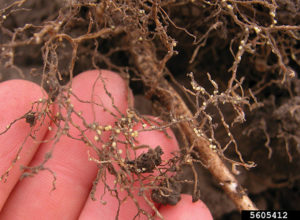Fungicide seed treatment in North Carolina soybean production
As North Carolina growers shift to using earlier soybean planting dates as a mechanism to increase soybean yield, questions arise about the value of a fungicide seed treatment at earlier planting dates, said NC soybean specialist Rachel Vann.
There is a lot of data generated several years ago to indicate that fungicide seed treatments do not impact North Carolina soybean yield at late May or later planting dates; investigation into the value of fungicide seed treatments at earlier planting dates is merited, she said.
In 2019 and 2020, the Soybean Extension Program looked at the value of fungicidal seed treatments for protecting stand and yield across diverse North Carolina environments in small-plot research. When the small-plot data was combined over years, maturity groups and fungicidal seed treatments, there was often a significant protection of both stand and yield at planting dates earlier than mid-May.
In 2020 and 2021, the soybean On Farm Trials (OFT) across the state focused on fungicide seed treatments. There was a significant protection of stand detected at many sites and significant protection of yield when you combined over the sites. Results from the OFT program in 2020 and 2021 can be found at https://bit.ly/36nmUNS.
Our current recommendation is for use of a fungicide seed treatment to protect stand and yield in soybean planting dates prior to mid-May, Vann said. Both the small-plot data and the OFT data from the past several years drives this current recommendation.
Stay on top of yield-robbing soybean cyst nematode
Nematodes are microscopic roundworms that live in the soil and feed on plant roots. According to Jeremiah Mullock, BASF product manager, seed treatment, soybean cyst nematode (SCN) is present in nearly all soybean geographies and is the leading cause of soybean yield loss in North America. In a 2020 study conducted by The SCN Coalition, soybean growers reported they perceive SCN reduces yield by 5.1 bushels per acre.
Soybean cyst nematodes enter plant roots and establish feeding sites that steal resources from the plant, leading to yield loss:
• Wounds created by feeding can cause cell death and weaken the plant.
• Damage increases as nematodes develop into adults and approach the reproductive stage.
• Cysts containing hundreds of eggs are formed after mating, leading to an explosion in the number of nematodes.
This underground cycle can be repeated three to six times during a single growing season and can wreak havoc for growers.
SCN symptoms are highly variable. They can range from none (no visible evidence of plant injury) to plant death in certain areas of the field. Here are some recommendations for creating a management plan to combat this pest.
First, take soil samples. If SCN is present in your fields, you’ll need to take immediate action. There is no easy fix for SCN. After you’ve tested your soil and know your SCN numbers, be sure to rotate resistant varieties and rotate to non-host crops. It’s also time to consider an effective seed treatment, Mullock said.
The BASF product manager said ILEVO seed treatment delivers direct mortality across all stages of nematode life cycle to prevent development and provides increased yield potentials by protection from nematode feeding and limits the impact of reproduction.
Sudden death syndrome (SDS) and SCN is estimated to be high, with at least 80% of SDS acres also impacted by SCN in the United States. SDS symptoms can be more severe under SCN pressure. While nematode damage increases in hot, dry conditions, SDS thrives in cool, wet conditions. ILEVO seed treatment protects against both, no matter the weather conditions, Mullock said.
Barber honored as soybean researcher of the year
Extension Weed Scientist Tom Barber receives a plaque as the Conservation Conferences soybean researcher of the year.
If not for a text from a colleague, Tom Barber might not have been on hand to receive his honor as Soybean Researcher of the Year from the Conservation Systems Conferences. Barber is an Extension weed scientist for the University of Arkansas System Division of Agriculture.
A large portion of Barber’s applied research in soybean revolves around managing pigweed.
“We discovered PPO resistance several years ago and have been working on a way to manage that in soybean,” he said. “And now we’ve identified glufosinate and dicamba resistance in some pigweed populations from northeast Arkansas, which will be a main focus for the program moving forward.
“In the last three years, we’ve been fortunate to work with several new technologies, one of which is the Redekop Seed Destructor as a means to destroy pigweed escapes at harvest and prevent future generations,” Barber said. “The Redekop seed destructor will be a game changer in the fight against resistant pigweed.”
Bob Scott, who worked alongside Barber as a weed scientist before becoming director of the Cooperative Extension Service, wrote the nomination.
“It is good to see Dr. Barber get recognition for his work in soybean,” Scott said. “Although he is more known as a cotton guy, he has worked very hard on issues over the year in soybean as well.”
Vic Ford, associate director-agriculture and natural resources for the Cooperative Extension Service, called Barber “a leader in his research and Extension programs. He is not an overnight success but a product of hard work and long hours to discover and disseminate timely results to Arkansas farmers,” Ford said. “Faculty like Tom support their support staff and program from grants and gifts. Dr. Barber’s program is one of the top in the country and that support demonstrates the value of the program.”
The post Industry News: April 2022 appeared first on Soybean South.
Fungicide seed treatment in North Carolina soybean production
As North Carolina growers shift to using earlier soybean planting dates as a mechanism to increase soybean yield, questions arise about the value of a fungicide seed treatment at earlier planting dates, said NC soybean specialist Rachel Vann.
There is a lot of data generated several years ago to indicate that fungicide seed treatments do not impact North Carolina soybean yield at late May or later planting dates; investigation into the value of fungicide seed treatments at earlier planting dates is merited, she said.
In 2019 and 2020, the Soybean Extension Program looked at the value of fungicidal seed treatments for protecting stand and yield across diverse North Carolina environments in small-plot research. When the small-plot data was combined over years, maturity groups and fungicidal seed treatments, there was often a significant protection of both stand and yield at planting dates earlier than mid-May.
In 2020 and 2021, the soybean On Farm Trials (OFT) across the state focused on fungicide seed treatments. There was a significant protection of stand detected at many sites and significant protection of yield when you combined over the sites. Results from the OFT program in 2020 and 2021 can be found at https://bit.ly/36nmUNS.
Our current recommendation is for use of a fungicide seed treatment to protect stand and yield in soybean planting dates prior to mid-May, Vann said. Both the small-plot data and the OFT data from the past several years drives this current recommendation.
Stay on top of yield-robbing soybean cyst nematode
Nematodes are microscopic roundworms that live in the soil and feed on plant roots. According to Jeremiah Mullock, BASF product manager, seed treatment, soybean cyst nematode (SCN) is present in nearly all soybean geographies and is the leading cause of soybean yield loss in North America. In a 2020 study conducted by The SCN Coalition, soybean growers reported they perceive SCN reduces yield by 5.1 bushels per acre.
Soybean cyst nematodes enter plant roots and establish feeding sites that steal resources from the plant, leading to yield loss:
• Wounds created by feeding can cause cell death and weaken the plant.
• Damage increases as nematodes develop into adults and approach the reproductive stage.
• Cysts containing hundreds of eggs are formed after mating, leading to an explosion in the number of nematodes.
This underground cycle can be repeated three to six times during a single growing season and can wreak havoc for growers.
SCN symptoms are highly variable. They can range from none (no visible evidence of plant injury) to plant death in certain areas of the field. Here are some recommendations for creating a management plan to combat this pest.
First, take soil samples. If SCN is present in your fields, you’ll need to take immediate action. There is no easy fix for SCN. After you’ve tested your soil and know your SCN numbers, be sure to rotate resistant varieties and rotate to non-host crops. It’s also time to consider an effective seed treatment, Mullock said.
The BASF product manager said ILEVO seed treatment delivers direct mortality across all stages of nematode life cycle to prevent development and provides increased yield potentials by protection from nematode feeding and limits the impact of reproduction.
Sudden death syndrome (SDS) and SCN is estimated to be high, with at least 80% of SDS acres also impacted by SCN in the United States. SDS symptoms can be more severe under SCN pressure. While nematode damage increases in hot, dry conditions, SDS thrives in cool, wet conditions. ILEVO seed treatment protects against both, no matter the weather conditions, Mullock said.
Barber honored as soybean researcher of the year
Extension Weed Scientist Tom Barber receives a plaque as the Conservation Conferences soybean researcher of the year.
If not for a text from a colleague, Tom Barber might not have been on hand to receive his honor as Soybean Researcher of the Year from the Conservation Systems Conferences. Barber is an Extension weed scientist for the University of Arkansas System Division of Agriculture.
A large portion of Barber’s applied research in soybean revolves around managing pigweed.
“We discovered PPO resistance several years ago and have been working on a way to manage that in soybean,” he said. “And now we’ve identified glufosinate and dicamba resistance in some pigweed populations from northeast Arkansas, which will be a main focus for the program moving forward.
“In the last three years, we’ve been fortunate to work with several new technologies, one of which is the Redekop Seed Destructor as a means to destroy pigweed escapes at harvest and prevent future generations,” Barber said. “The Redekop seed destructor will be a game changer in the fight against resistant pigweed.”
Bob Scott, who worked alongside Barber as a weed scientist before becoming director of the Cooperative Extension Service, wrote the nomination.
“It is good to see Dr. Barber get recognition for his work in soybean,” Scott said. “Although he is more known as a cotton guy, he has worked very hard on issues over the year in soybean as well.”
Vic Ford, associate director-agriculture and natural resources for the Cooperative Extension Service, called Barber “a leader in his research and Extension programs. He is not an overnight success but a product of hard work and long hours to discover and disseminate timely results to Arkansas farmers,” Ford said. “Faculty like Tom support their support staff and program from grants and gifts. Dr. Barber’s program is one of the top in the country and that support demonstrates the value of the program.”
The post Industry News: April 2022 appeared first on Soybean South.




